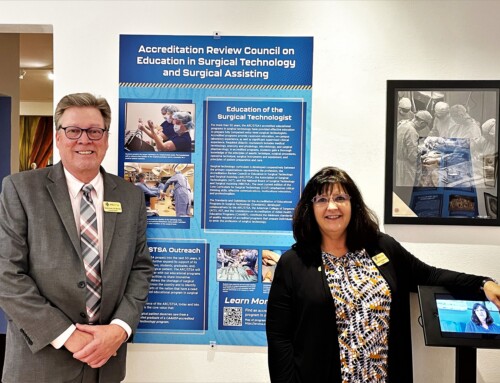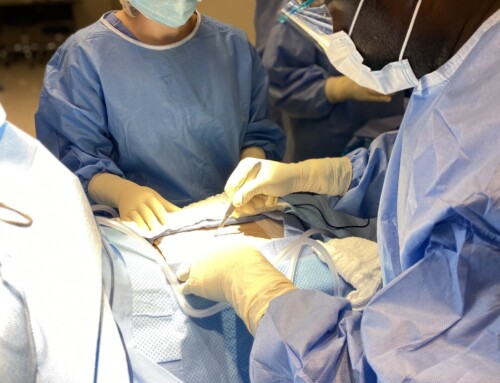By Rebecca Hall, MS, CRCST, CSA, CST, FAST
Recognized for the sixth consecutive year as a tech-savvy college by the Center for Digital Education, Delta College incorporates technology to improve curriculum delivery and service across its programs. Following this tradition, our surgical first assistant and surgical technology programs were the first in the state of Michigan to use the Anatomage Table to supplement and support our advanced anatomy courses in a highly interactive and engaging manner.
The Anatomage Table is an operatory bed-sized interactive touch screen table in which real human cadavers and their individual systems and structures are reconstructed into accurate three-dimensional (3D) images. We can then cut and view these images on any plane, and rotate, flip and enlarge them on any axis to show detail. The Anatomage Table comes with a male and a female cadaver as well as hundreds of pathology cases showing both normal anatomy and abnormal pathologies.
Rebecca Hall shows Delta SFA & ST students features of the Anatomage Table.
Using the Anatomage Table, each student can peel away layers down to viscera, vessels, lymph nodes, and nerves of the body. Students have the opportunity to have hands-on, multi-dimensional experience in dissecting a digital cadaver to observe structures highlighted in each lecture and course objective, and can observe physiological functions in action like watching the heart pump blood throughout the body or watching food travel through the gastrointestinal tract. Being able to see how cardiac and other vital functions are carried out, helps students conceptualize and better understand these physiological functions.
We have found that the Anatomage Table has really helped our students embrace learning not only surgical anatomy but also new technologies, both of which are critical to their future success in the OR.
Anatomage Table showing the venous system
You may wonder how this detail is accomplished. Anatomage’s Chieu Le explained that creating the 3D images is a painstakingly complex process:
Donated bodies were frozen, serially sliced, then photographed with high-resolution cameras. The slice thickness ranges for each cadaver but some are as thin as 0.05 mm, resulting in thousands of images per body. These images are then collected, color-corrected, and aligned by the Anatomage team for the best quality 3D reconstruction possible. Next, our team of 3D artists reviews each slice and traces the visible anatomical structures: bones, muscles, blood vessels, organs, etc. These tracings and other inputs are entered into Anatomage’s software allowing us to reconstruct the body based on real human anatomy. This detailed segmentation process can take up to two years per cadaver to complete.
The decision to purchase the Anatomage Table was a team effort. Funds were available in the education budget, and I suggested to the Simulator Educator for our Health and Wellness Division, Lori Kloc, that we purchase the Anatomage Table. After some research, we realized that many programs could benefit from using the table, and Delta was on board. Kloc and I were selected to receive Delta’s Robert DeVinney Endowed Teaching Chair grant, which supports the innovative use or study of technology in the classroom or other learning environment. This funding allowed us to attend the Anatomage User Conference in San Jose, California.
At the conference, we had the opportunity to learn how to incorporate the table into our curriculum. Back at Delta, Kloc developed training sessions for other programs such as Ultrasonography, Radiography, and Nursing. The table is housed in the surgical technology classroom, and we use it consistently every fall for surgical anatomy, taught by our instructors Michael Gring, BA, CST, and Meg Muno, BBA, CST.
Gring, who has been our anatomy instructor for the SFA program for several years, is a huge proponent of the Anatomage Table and shared that his favorite part of using the table is that students can see anatomy that is abnormal.
“We are so fortunate to have not one but two Anatomage Tables for our students,” Gring said. “The quality and level of minute detail in the structures is unparalleled and students are always astonished to see me move the 3D cadaver around with a pinch of my fingertips. The images really capture the students’ interest and attention. It’s so important for them to see not just normal anatomy in a textbook, but abnormal anatomy that they could encounter in the OR.”
Gring and Muno even create anatomy quizzes by placing numbered pins in structures on the digital cadaver that students are expected to identify, just as in a gross anatomy course with a cadaver. The anatomy included on a quiz or in a lecture can be viewed directly on the Anatomage Table or projected onto large screens for class viewing.
Anatomage offers an eBook online learning platform for students as well as the Anatomage Table Companion app available for the iPad. At Delta, we use a triad of resources to teach surgical anatomy that includes textbooks, the Anatomage Table, and the iPad for the eBook. Delta made the decision to move all surgical assisting courses online due to COVID-19, and we took the initiative to create a “virtual anatomy lab” for students using the iPad and Anatomage app which allowed for seamless continuity of instruction for anatomy lessons. Students can also come to campus and bring their own USB drive to insert into the Anatomage Table to save images and quizzes.
The combination of Anatomage, its companion app, and instructor-led Zoom lectures, where our instructors remotely control, manipulate and dissect the cadaver, has boosted student engagement and led to very positive student feedback.
Rebecca Hall, MS, CRCST, CSA, CST, FAST, is an associate professor and clinical coordinator for the surgical technology program and the program coordinator for the surgical first assistant program and sterile processing program. Rebecca has been a CST for 25 years and a CSA for 17 years. She currently serves as the vice president for the Association of Surgical Assistants (ASA), has served the Michigan State Assembly as president, vice president, board member, and treasurer, and has served AST as a board member and ASA as secretary and treasurer. Rebecca also volunteers as a site visitor for ARC/STSA. Rebecca feels very blessed to be able to share this profession with her students.
Looking for financial assistance to aquire an Anatomage Table or other simulators for your program? Here are funding resources that programs have leveraged to support student learning:
- Perkins CTE grant
- US Department of Education Strengthening Institutions Program (SIP) grant
- Other USDOE grants
- Donations from healthcare systems
- Grants from physician groups
- State departments of education grants
- State community college systems – innovation/technology grants
- State tax credits
- State grants: rehabilitation/repair, innovation, technology, skills, STEM, etc.
- State workforce commission grants
- Alumni foundations/grants






